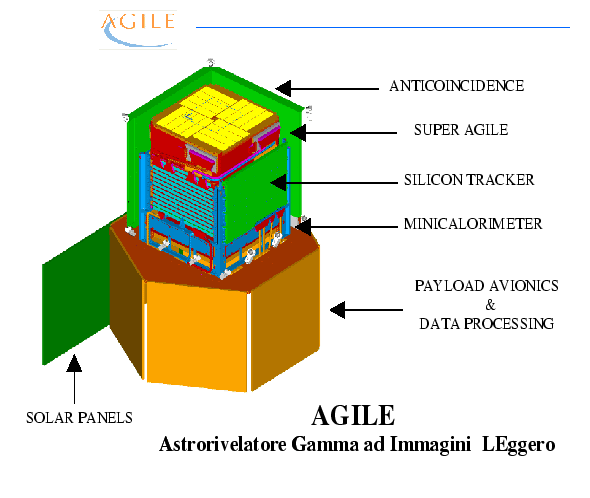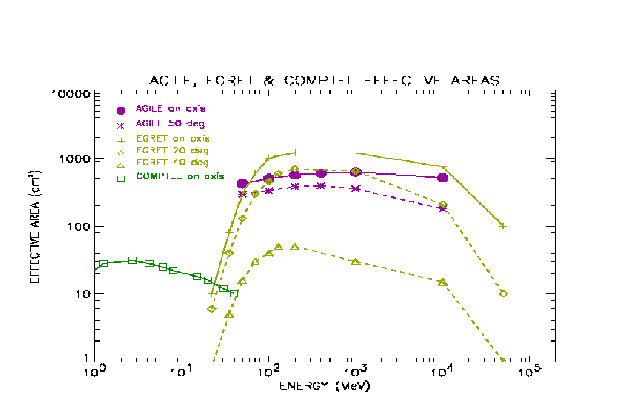



Next: On-board tracks reconstruction
Up: AGILE performances optimization
Previous: AGILE performances optimization
Contents
The GRID instrument will be the gamma-ray imager of AGILE, it will be formed by a Silicon-Tungsten tracker and a calorimeter of Iodine-Cesium.
AGILE will also have a coded-mask X-ray imager (called Super-AGILE), sensitive in the energy range 15 - 45 keV.
A system of anticoincidences formed by 13 panels of plastic scintillator will cover the instrument on the top and lateral sides.
The tracker is formed by 12 planes, each plane (with the exception of the two at the bottom) are made by a tungsten converter layer
 thick (corresponding to
thick (corresponding to  radiation length), and two layers of silicon in which are implanted the microstrips arranged in orthogonal directions to provide the X and Y coordinates of the particle tracks.
The last two have only the silicon layers.
radiation length), and two layers of silicon in which are implanted the microstrips arranged in orthogonal directions to provide the X and Y coordinates of the particle tracks.
The last two have only the silicon layers.
Figure 4.1:
The AGILE satellite. The height of the payload is approximately 0.5 m [Tavani et al., 2003].
 |
The tracker planes have a geometric area of 1444  and the distance between consecutive planes is
and the distance between consecutive planes is  mm.
Each silicon plane is constituted by an array of
mm.
Each silicon plane is constituted by an array of
 square tiles, with a side of
square tiles, with a side of  cm, which constitute the elementary detection cell. The microstrip (that have a pitch of 121
cm, which constitute the elementary detection cell. The microstrip (that have a pitch of 121  ), permit of obtain, using an interpolation algorithm , a measurement of the hits position with an accuracy of about 40
), permit of obtain, using an interpolation algorithm , a measurement of the hits position with an accuracy of about 40  , for a wide range of incidence angles.
The readout electronics of the silicon strips will work both for collecting tracker information and for trigger purpose of the whole apparatus.
This feature, implemented for the first time in space, guarantees to AGILE its large field of view.
The tracker has an on-axis total radiation length larger than 0.84. The resulting effective area is shown in figure 4.2.
The Mini-calorimeter consist of two planes of Cesium Iodine bars for a total of 1.5 radiation length.
It will allow to estimate the energy of the incident photons imaged by the tracker.
In addition the Mini-calorimeter will be used to study the gamma-ray bursts in the 350 keV - 100 MeV range.
The two planes have the bars arranged in orthogonal directions to provide the X and Y location of the shower.
The scintillation light is collected by photodiodes placed at both ends of each bar.
The Super-AGILE detector is based on the 9.5
, for a wide range of incidence angles.
The readout electronics of the silicon strips will work both for collecting tracker information and for trigger purpose of the whole apparatus.
This feature, implemented for the first time in space, guarantees to AGILE its large field of view.
The tracker has an on-axis total radiation length larger than 0.84. The resulting effective area is shown in figure 4.2.
The Mini-calorimeter consist of two planes of Cesium Iodine bars for a total of 1.5 radiation length.
It will allow to estimate the energy of the incident photons imaged by the tracker.
In addition the Mini-calorimeter will be used to study the gamma-ray bursts in the 350 keV - 100 MeV range.
The two planes have the bars arranged in orthogonal directions to provide the X and Y location of the shower.
The scintillation light is collected by photodiodes placed at both ends of each bar.
The Super-AGILE detector is based on the 9.5  9.5
9.5  silicon tiles that are used for the tracker planes.
These will be placed on the top of the tracker to form an additional detection plane sensitive in the 10-40 keV range and used in conjunction with a coded mask at a distance of 14 mm. Since the microstrips provide pixels only along one dimension, Super-AGILE will consist of four equal modules arranged in two pairs, giving monodimensional sky images along two orthogonal directions.
The extension in the hard X-ray range of a gamma-ray mission, made possible by the Super-AGILE detector, is an innovative concept that will allow the study of correlated variability for sources of different classes, ranging from active galactic nuclei and blazars to unidentified galactic transients.
The Anticoincidence system, aimed at charged particle background rejection, is formed by a top panel and 12 lateral panels.
Each panel is made by plastic scintillator, the scintillation light is collected by optical fibers and directed to 16 photomultipliers.
silicon tiles that are used for the tracker planes.
These will be placed on the top of the tracker to form an additional detection plane sensitive in the 10-40 keV range and used in conjunction with a coded mask at a distance of 14 mm. Since the microstrips provide pixels only along one dimension, Super-AGILE will consist of four equal modules arranged in two pairs, giving monodimensional sky images along two orthogonal directions.
The extension in the hard X-ray range of a gamma-ray mission, made possible by the Super-AGILE detector, is an innovative concept that will allow the study of correlated variability for sources of different classes, ranging from active galactic nuclei and blazars to unidentified galactic transients.
The Anticoincidence system, aimed at charged particle background rejection, is formed by a top panel and 12 lateral panels.
Each panel is made by plastic scintillator, the scintillation light is collected by optical fibers and directed to 16 photomultipliers.
The expected scientific performances of AGILE are summarized in table 4.1.
One of the main characteristics of the AGILE gamma-ray detector is its very large field of view.
As shown in figure 4.2 the AGILE effective area remains almost constant for large off-axis angles.
This will allow to simultaneously monitor a large number of sources in a single pointing and will also result, at the end of the mission, in a large exposure factor for each region of the sky.
The great sky exposure factor, coupled with the good angular resolution, will allow a detailed study of the diffuse Galactic and extra-Galactic emission and to better locate the unidentified EGRET sources.
The expected sensitivity for regions along the Galactic plane is shown in figure 4.4.
Another important characteristic of the AGILE tracker is the very small dead time, about 100  (i.e. three orders of magnitude smaller than for EGRET).
Furthermore, an on-board GPS system will allow to time tag the photons with an absolute accuracy of only a few
(i.e. three orders of magnitude smaller than for EGRET).
Furthermore, an on-board GPS system will allow to time tag the photons with an absolute accuracy of only a few  .
.
Figure 4.2:
The AGILE effective area as function of energy and for different angles, compared to that of other instruments [Tavani et al., 2003].
 |
Figure 4.3:
The AGILE Point Spread Functions function of energy, preliminary results [Giuliani et al., 2004].
 |
Figure 4.4:
The AGILE Sensitivity for a point source on the galactic plane, seen at 30 degree of off-axis angle, for different observation time.
Earth occultation and a residual particle background are also taken into account. The spectrum of the Crab pulsar is shown as comparison [Tavani et al., 2003].
|
As shown in figure 4.6, the AGILE PSF on-axis (shown at  containment radius) is expected to be better than that of EGRET by a factor of
containment radius) is expected to be better than that of EGRET by a factor of  above 400 MeV.
The angular resolution is weakly dependent on incidence angle (
above 400 MeV.
The angular resolution is weakly dependent on incidence angle ( ), increasing of only a factor 2 for off-axis angle of 60 degrees.
), increasing of only a factor 2 for off-axis angle of 60 degrees.




Next: On-board tracks reconstruction
Up: AGILE performances optimization
Previous: AGILE performances optimization
Contents
Andrea Giuliani
2005-01-21


